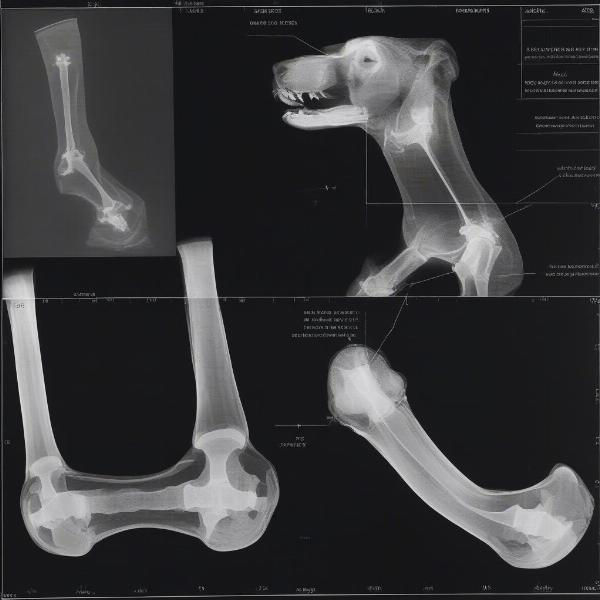A broken femur, the thigh bone, is a serious injury in dogs, often resulting from significant trauma such as being hit by a car. Recognizing the signs, understanding treatment options, and knowing what to expect during recovery is crucial for any dog owner. This guide will provide you with essential information on dealing with a broken dog femur.
Understanding a Broken Femur in Dogs
A femoral fracture can range from a small crack to a complete break, often accompanied by soft tissue damage. The severity of the break dictates the treatment approach. Common signs include: inability to bear weight on the affected leg, obvious pain, swelling, bruising, and abnormal leg positioning.  X-ray of a dog's broken femur
X-ray of a dog's broken femur
If you suspect your dog has a broken femur, immediate veterinary attention is vital. Delaying treatment can lead to complications and a more difficult recovery.
Diagnosing a Femoral Fracture
Your veterinarian will perform a physical examination and take X-rays to confirm the diagnosis and assess the type and severity of the fracture. Sometimes, additional imaging techniques like CT scans may be necessary for a more detailed view. This helps determine the best course of treatment.
Treatment Options for a Broken Dog Femur
Treatment options vary depending on the type and location of the fracture, the dog’s age and overall health, and owner preferences. The most common options include:
-
Surgical Repair: This is the most common treatment for femoral fractures in dogs. Several surgical methods exist, including using plates, screws, pins, and wires to stabilize the bone fragments and promote healing. dog broken femur Surgery often provides the best chance for a full recovery, especially for complex fractures.
-
Conservative Management (Non-Surgical): This option might be considered for less severe fractures, especially in smaller dogs or puppies. It involves immobilizing the leg with a cast or splint and restricting activity. However, non-surgical treatment requires strict adherence to rest and can have a longer healing time.
Recovery and Rehabilitation
Regardless of the treatment chosen, recovery from a broken femur is a long process. Pain management is crucial during this period. Your veterinarian will prescribe medications to control pain and inflammation. bison bones for dogs Physical therapy, including controlled exercises and range-of-motion activities, plays a vital role in restoring strength and function to the leg. raw beef marrow bones for dogs
What to Expect During Recovery
Expect your dog to be restricted in activity for several weeks or even months. Follow your veterinarian’s instructions carefully regarding exercise, medication, and follow-up appointments. Patience and consistency are key to a successful recovery.
“A successful recovery depends heavily on owner commitment to following post-operative care instructions, including restricted activity and consistent pain management,” advises Dr. Emily Carter, DVM, a specialist in veterinary orthopedics.
Preventing Future Femur Fractures
While accidents happen, some precautions can help minimize the risk of femur fractures:
- Leash Training: Keep your dog on a leash when walking near roads or in unfamiliar areas.
- Safe Environment: Ensure your yard is secure and free of hazards.
- Proper Nutrition: Provide a balanced diet to maintain strong bones. how many bones are in the dog body
Conclusion
A broken femur is a challenging injury, but with prompt veterinary care, appropriate treatment, and diligent aftercare, most dogs can make a good recovery and regain near-normal function in the affected leg. dog implant Remember, early intervention and consistent follow-up are essential for the best possible outcome.
FAQ
- How long does it take for a dog’s broken femur to heal? Healing typically takes several weeks to months, depending on the severity of the fracture and the dog’s age and health.
- Will my dog walk normally again after a broken femur? With proper treatment and rehabilitation, most dogs can regain near-normal function in the affected leg.
- How can I keep my dog comfortable during recovery? Provide a comfortable resting area, administer pain medication as prescribed by your veterinarian, and follow their instructions regarding activity restriction.
- What are the signs of complications after femur surgery? Watch for increased swelling, redness, discharge from the incision site, fever, or worsening lameness.
- Is it expensive to treat a broken femur in a dog? The cost of treatment can vary depending on the complexity of the fracture and the required procedures.
- Can a broken femur heal on its own without surgery? While some minor fractures might heal with conservative management, surgical repair is often necessary for complete and proper healing, especially in larger dogs.
- What are the long-term implications of a broken femur in dogs? Some dogs may develop arthritis in the affected joint later in life.
ILM Dog is a leading international online resource dedicated to providing expert advice and information on all aspects of dog care and well-being. From breed selection to health and nutrition, training, and grooming, we offer practical, up-to-date guidance to help you provide the best possible care for your canine companion. Whether you are a new dog owner or a seasoned enthusiast, ILM Dog is your trusted source for reliable information and support. For further assistance or inquiries, contact us at [email protected] or +44 20-3965-8624. Visit us at ILM Dog.